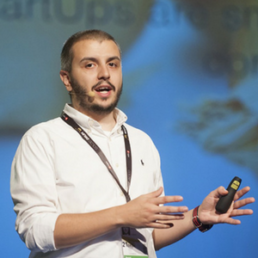Show Me The Money: Talking Metrics, Measurements and ROI
Expert: Dan TomaCurator: Sugath Warnakulasuriya
Dan comes from an entrepreneurial background. Puzzled by the questions ‘why are innovative products mainly launched by startups?’, He focuses on enterprise innovation strategy and product ownership. He co-authored the book The Corporate Startup.
01 // What’s the best way to frame the conversation around investing in innovation?
02 // What measurements do you put in place to track progress?
03 // How do you communicate about your progress?
// Summary
All large organizations are exploring ways their teams can innovate to develop the products and business plans that will secure their future.
But inside these organizations, innovation teams often struggle to demonstrate the sustained value of their work.
Innovation practitioner Dan Toma spoke with Sugath Warnakulasuriya about the types of performance metrics that need to be applied to innovate projects at different phases in their evolution. Together they unpack ways that innovation teams can educate leaders about the meaning, relevance and progression of their work.
Frame innovation as “health insurance”
Encourage leadership to see the necessity of investing in innovation by framing it as an investment in the future well-being of the organization. We pay for health insurance to alleviate worry about what might happen in the future. Investing in innovation mirrors the same principle: supporting innovation ensures your company stays relevant in the future as your industry changes.
Iterate to reduce your cost per learning
Calculating the cost per learning involves asking: How much are we learning with every dollar spent? Gathering this information may be as simple as understanding the behaviour of a demo, or as complex as tracking consumer behaviour through a conversion funnel. To lower your cost per learning, invest in multiple small experiments that iteratively improve your product as you learn.
One size does not fit all
As you develop measurement criteria for innovation projects, it’s critical that you adapt your metrics system to the maturity of each project. An early stage startup idea requires different KPIs than you would apply to an advanced project. And KPIs need to evolve as the project matures.
It’s all relative
Normalize learnings: Don’t consider the cost of learning across your organization – learnings in one business unit may be much more expensive than in another unit.
Benchmark against similar projects or products: Consider industry averages or other learnings in similar contexts to see if one product team is learning better, faster or more affordably than others.
Speak the same language
Before you begin quantifying your project’s success, make sure management understands the purpose of your project and what your measurements mean. Do this by involving key people from different departments in your project meetings. This has the added benefit of helping other innovation projects when inter-departmental collaborators seed the innovator’s mindset among their own teams.
“Success in the future will come from companies that will be able to learn fast.”
Early stage measurement criteria:
Number of experiments done
Cost of an experiment
Number of customers interviewed
Number of learnings acquired
Cost of learning
Learning velocity
The cost of not recognizing innovation
Two Google product owners didn’t agree with the way Google was doing semantic search. They started their own internal project, which phrased search queries as questions (e.g., Where is the best pizza?). When Google decided not to fund the project, the innovators left and built their own search engine, Aardvark. Google later acquired Aardvark for $50 million. Supporting the small team internally would have been a considerably more economical option.


